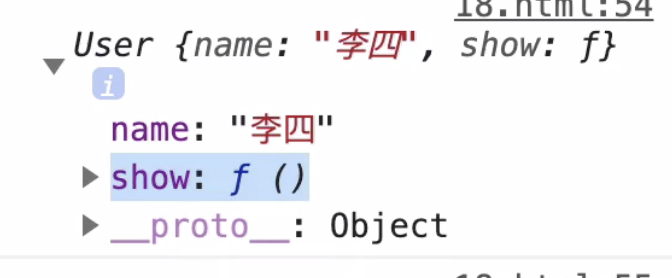JS原型链(一)
文章目录
一、对象构造函数,原型对象,实例对象之间的关系
-
构造函数通过 protype属性 指向 原型对象
-
原型对象通过 constructor属性 指向 构造函数
-
原型对象通过 new 的形式 实例化 并 创建 实例对象
-
实例对象通过 proto 属性 指向 原型对象
function Person(nick, age) {
this.nick = nick;
this.age = age;
}
Person.prototype.sayName = function() {
console.log(this.nick);
}
const zhangsan = new Person('张三', 20);
const lisi = new Person('李四', 21);
zhangsan.sayName(); // 张三
lisi.sayName(); // 李四
console.log(zhangsan.__proto__.sayName); // 张三
console.log(zhangsan.__proto__ === Person.prototype); // true
console.log(zhangsan.__proto__ === lisi.__proto__); // true
console.log(zhangsan.__proto__.constructor === Person); // true
二、原型链继承
- 对象属性继承
function Person(name, age) {
this.name = name;
this.age = age;
}
Person.prototype.getName = function () {console.log(this.name)}
function Teacher(name, age, subject) {
Person.call(this, name, age); // call会执行Person构造方法
this.subject = subject;
}
var teacher = new Teacher('jack', 15, 'Math');
console.log(teacher.age);
console.log(teacher.name);
- 方法继承
Object.create(); 会创建一个无原型对象
Teacher.prototype = Object.create(Person.prototype);
console.log(Teacher.prototype.constructor); // [Function: Person]
三、常用API
obj.__proto__等于Object.getPrototypeOf(obj)obj.__proto__.constructor用于获取构造函数__proto__是ES6标准,Object.getPrototypeOf(obj)是老标准,用于获取对象实例的原型。
function User(name, age) {
this.name = name;
this.age = age;
}
function createByObject(obj, ...args) {
// const constructor = Object.getPrototypeOf(obj).constructor;
const constructor = obj.__proto__.constructor;
return new constructor(...args);
}
let hd = new User("后盾人");
let xj = createByObject(hd, "向军", 12);
console.log(xj);
四、常见问题
一、什么是原型与原型链
- 原型
在javascript中,函数可以有属性。每个函数都有-一个特殊的属性叫作原型(prototype)。
- 原型链
原型链就是当我们访问对象的某个属性或方法时,如果在当前对象中找不到定义,会继续在当前对象的原型对象中查找,如果原型对象中依然没有找到,会继续在原型对象的原型中查找(原型也是对象,也有它自己的原型)如此继续,直到找到为止,或者查找到最顶层的原型对象中也没有找到,就结束查找,返回undefined。可以看出,这个查找过程是一个链式的查找,每个对象都有一个到它自身原型对象的链接,这些链接组件的整个链条就是原型链。
二、原型和原型链存在的意义是什么?
使得实例对象可以共享构造函数原型属性和方法,节省内存。构造函数原型上的属性和方法越多,节省内存越大.
补充
一、in与hasOwnProperty属性检测差异
- in会攀升原型链检测,hasOwnProperty只会检测实例对象本身
let a = { url: 'houdunre' };
let b = { name: '后盾人' };
Object.prototype.web = '后盾人';
'web' in a; // true
'name' in a; // false
Object.setPrototypeOf(a, b);
console.log(a.__proto__); // { name: '后盾人' }
'name' in a; // true
a.hasOwnProperty('name'); // false
for(const key in a ){
// 只遍历实例对象的属性
if(a.hasOwnProperty(key)) {
const element = object[key];
}
}
二、isPrototypeOf 原型链检测
let a = {}; let b = {};
Object.setPrototypeOf(a,b); // b是a的爹
console.log(b.isPrototypeOf(a)); // true
三、DOM节点借用Array原型方法
<script>
let arr = [1, 3, 43];
let res = arr.filter(item => {
return item > 39;
});
console.log(res);
let btns = document.querySelectorAll('button');
btns = Array.prototype.filter.call(btns, item => {
return item.hasAttribute('class');
});
console.log(btns[0].innerHTML);
</script>
四、合理的构造函数声明
问题:不合理的构造函数
function User(name) {
this.name = name;
this.show = function() {
console.log(this.name);
}
}
可以看到,这样创建的函数会被绑定到每个实例对象上,会浪费内存空间。
合理的做法:将共享方法绑定到prototype上
function User(name) {
this.name = name;
}
User.prototype.show = function() {
console.log(this.name);
}
如果构造函数需要定义的方法较多,可以将原型声明为一个对象
function User(name) {
this.name = name;
}
User.prototype = {
constructor: User, // 记得绑定构造函数
show() {
console.log(this.name);
},
get() {
console.log(this.name);
}
}
五、__proto__
1. Object.setPrototypeOf与Object.setPrototypeOf
由于__proto__是ES6标准,ES5可以使用Object提供的Object.setPrototypeOf代替__proto__= xxx
let hd = { name: '后盾人' }
let user = { show: function() {return this.name} }
Object.setPrototypeOf(hd, user); // 代替__proto__ = xxx
// hd.__proto__ = user;
console.log(Object.getPrototypeOf(hd)); // 代替__proto__
// console.log(hd.__proto__);
2. __proto__不是一个属性
let hd = { name: '后盾热' };
hd.__proto__ = {
show() {
console.log(this.name);
}
};
hd.__proto__ = 10;
// { show: [Function: show] }
console.log(hd.__proto__);
可以看到直接对__proto__赋值是无效的,__proto__是一个具备getter和setter的访问器。
自定义实现proto
let obj = {proto: {},}
Object.defineProperty(obj, 'proto', {
get() {
return proto;
},
set(obj) {
console.log('set proto');
if(obj instanceof Object) {
proto = obj;
}
}
})
let a = {name: '张三'};
let b = {
show: function() {
console.log(this.name);
}
};
Object.setPrototypeOf(a, obj);
a.proto = b;
a.proto.show.call(a, null);
六、!!!原型链可以实现JS继承与多态
1. JS继承的本质是原型链的继承
function Entity() {};
Entity.prototype = {
constructor: Entity,
name: 'Entity',
id: Math.floor(Math.random()*10)
}
function Person() {}
Person.prototype.nickName = '昵称';
Person.prototype.__proto__ = Entity.prototype;
const p1 = new Person();
console.log(p1.nickName);
2. Object.create实现继承
function User() {}
User.prototype.show = function() {
console.log('user.show()');
}
function Admin() {}
Admin.prototype = Object.create(User.prototype);
// Admin.prototype.constructor = Admin;
let a = new Admin();
console.log(a.constructor); // User
function User() {}
User.prototype.name = function() {
console.log('user.name()');
}
function Admin() {}
Admin.prototype = Object.create(User.prototype);
// 这样可以避免for in循环去遍历原型链的问题
Object.defineProperty(Admin.prototype, 'constructor', {
value: Admin,
enumerable: false
})
Admin.prototype.role = function() {
console.log('admin.role');
}
console.log(
Object.getOwnPropertyDescriptors(Admin.prototype)
);
let a = new Admin();
3. 原型链实现方法重写
function User() {}
User.prototype.show = function() {
console.log('user.show()');
}
function Admin() {}
Admin.prototype = Object.create(User.prototype);
Admin.prototype.constructor = Admin;
Admin.prototype.show = function () {
console.log('admin.show()');
}
let hd = new Admin();
hd.show();
4. 对象的多态
function User() {}
User.prototype.description = 'User';
User.prototype.show = function() {
console.log(this.description());
}
function Admin() {}
Admin.prototype = Object.create(User.prototype);
Admin.prototype.construction = Admin;
Admin.prototype.description = function() {return '管理员'}
function Member() {}
Member.prototype = Object.create(User.prototype);
Member.prototype.construction = Member;
Member.prototype.description = function() {return '成员'}
function Enterprise() {}
Enterprise.prototype = Object.create(User.prototype);
Enterprise.prototype.construction = Enterprise;
Enterprise.prototype.description = function() {return '企业用户'}
for (const obj of [new Admin(), new Member(), new Enterprise()]) {
obj.show();
}
5. 在子类中使用父类构造方法
function User(name, age) {
this.name = name;
this.age = age;
}
User.prototype.show = function() {
console.log(this.name, this.age);
};
function Admin(name, age) {
User.call(this, name, age);
}
Admin.prototype = Object.create(User.prototype);
let admin = new Admin('管理员', 18);
admin.show();
利用apply方法可以简化子类构造方法的调用
function User(name, age) {
this.name = name;
this.age = age;
}
User.prototype.show = function() {
console.log(this.name, this.age);
};
function Admin(...args) {
User.apply(this, args);
}
Admin.prototype = Object.create(User.prototype);
let admin = new Admin('管理员', 18);
admin.show();
6. 使用原型工厂封装继承
function User() {}
function Admin() {}
function extend(sub, sup) {
sub.prototype = Object.create(sup.prototype);
Object.defineProperty(sub.prototype, 'constructor', {
value: sub,
enumerable: false
});
}
extend(Admin, User);
User.prototype.name = function() {
console.log('user.name');
}
Admin.prototype.role = function() {
console.log('admin.role');
}
let a = new Admin();
a.role();
a.name();






















 231
231











 被折叠的 条评论
为什么被折叠?
被折叠的 条评论
为什么被折叠?








